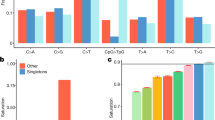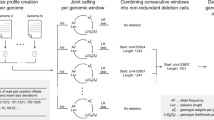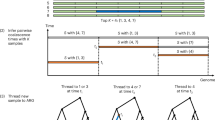Abstract
Accurate and complete analysis of genome variation in large populations will be required to understand the role of genome variation in complex disease. We present an analytical framework for characterizing genome deletion polymorphism in populations using sequence data that are distributed across hundreds or thousands of genomes. Our approach uses population-level concepts to reinterpret the technical features of sequence data that often reflect structural variation. In the 1000 Genomes Project pilot, this approach identified deletion polymorphism across 168 genomes (sequenced at 4× average coverage) with sensitivity and specificity unmatched by other algorithms. We also describe a way to determine the allelic state or genotype of each deletion polymorphism in each genome; the 1000 Genomes Project used this approach to type 13,826 deletion polymorphisms (48–995,664 bp) at high accuracy in populations. These methods offer a way to relate genome structural polymorphism to complex disease in populations.
This is a preview of subscription content, access via your institution
Access options
Subscribe to this journal
Receive 12 print issues and online access
$209.00 per year
only $17.42 per issue
Buy this article
- Purchase on Springer Link
- Instant access to full article PDF
Prices may be subject to local taxes which are calculated during checkout





Similar content being viewed by others
References
1000 Genomes Project Consortium et al. A map of human genome variation from population scale sequencing. Nature 467, 1061–1073 (2010).
Ye, K., Schulz, M.H., Long, Q., Apweiler, R. & Ning, Z. Pindel: a pattern growth approach to detect break points of large deletions and medium sized insertions from paired-end short reads. Bioinformatics 25, 2865–2871 (2009).
Lam, H.Y. et al. Nucleotide-resolution analysis of structural variants using BreakSeq and a breakpoint library. Nat. Biotechnol. 28, 47–55 (2010).
Korbel, J.O. et al. Paired-end mapping reveals extensive structural variation in the human genome. Science 318, 420–426 (2007).
Korbel, J.O. et al. PEMer: a computational framework with simulation-based error models for inferring genomic structural variants from massive paired-end sequencing data. Genome Biol. 10, R23 (2009).
Chen, K. et al. BreakDancer: an algorithm for high-resolution mapping of genomic structural variation. Nat. Methods 6, 677–681 (2009).
Chiang, D.Y. et al. High-resolution mapping of copy-number alterations with massively parallel sequencing. Nat. Methods 6, 99–103 (2009).
Yoon, S., Xuan, Z., Makarov, V., Ye, K. & Sebat, J. Sensitive and accurate detection of copy number variants using read depth of coverage. Genome Res. 19, 1586–1592 (2009).
Alkan, C. et al. Personalized copy number and segmental duplication maps using next-generation sequencing. Nat. Genet. 41, 1061–1067 (2009).
Mills, R.E. et al. Mapping copy number variation by population scale sequencing. Nature published online, doi:1:10.1038/nature09708 (3 February 2011).
McCarroll, S.A. et al. Integrated detection and population-genetic analysis of SNPs and copy number variation. Nat. Genet. 40, 1166–1174 (2008).
Conrad, D.F. et al. Origins and functional impact of copy number variation in the human genome. Nature 464, 704–712 (2010).
Tuzun, E. et al. Fine-scale structural variation of the human genome. Nat. Genet. 37, 727–732 (2005).
Iskow, R.C. et al. Natural mutagenesis of human genomes by endogenous retrotransposons. Cell 141, 1253–1261 (2010).
Huang, C.R. et al. Mobile interspersed repeats are major structural variants in the human genome. Cell 141, 1171–1182 (2010).
Mills, R.E. et al. An initial map of insertion and deletion (INDEL) variation in the human genome. Genome Res. 16, 1182–1190 (2006).
Li, H. & Durbin, R. Fast and accurate long-read alignment with Burrows-Wheeler transform. Bioinformatics 26, 589–595 (2010).
Marchini, J., Howie, B., Myers, S., McVean, G. & Donnelly, P. A new multipoint method for genome-wide association studies by imputation of genotypes. Nat. Genet. 39, 906–913 (2007).
Li, Y., Willer, C., Sanna, S. & Abecasis, G. Genotype imputation. Annu. Rev. Genomics Hum. Genet. 10, 387–406 (2009).
Browning, B.L. & Browning, S.R. A unified approach to genotype imputation and haplotype-phase inference for large data sets of trios and unrelated individuals. Am. J. Hum. Genet. 84, 210–223 (2009).
Coin, L.J. et al. cnvHap: an integrative population and haplotype-based multiplatform model of SNPs and CNVs. Nat. Methods 7, 541–546 (2010).
International HapMap3 Consortium et al. Integrating common and rare genetic variation in diverse human populations. Nature 467, 52–58 (2010).
International HapMap Consortium. A haplotype map of the human genome. Nature 437, 1299–1320 (2005).
McCarroll, S.A. et al. Deletion polymorphism upstream of IRGM associated with altered IRGM expression and Crohn's disease. Nat. Genet. 40, 1107–1112 (2008).
Willer, C.J. et al. Six new loci associated with body mass index highlight a neuronal influence on body weight regulation. Nat. Genet. 41, 25–34 (2009).
Li, H., Ruan, J. & Durbin, R. Mapping short DNA sequencing reads and calling variants using mapping quality scores. Genome Res. 18, 1851–1858 (2008).
Acknowledgements
The authors wish to thank the 1000 Genomes Structural Variation Analysis Group for helpful conversations throughout this work and for collaborative work to evaluate the sensitivity and specificity of structural variation discovery algorithms. We would particularly like to acknowledge K. Chen for creation of a high-quality breakpoint library for the 1000 Genomes Project, on which Genome STRiP's genotyping algorithm drew, and R. Mills for managing the 1000 Genomes Project deletion discovery sets and validation data. We also thank C. Stewart, K. Walter, M. Hurles and N. Patterson for helpful conversations during the course of this work; D. Altshuler, M. DePristo and M. Daly for helpful comments on the manuscript and figures; and the anonymous reviewers of this manuscript, whose feedback improved it. This work was supported by the National Human Genome Research Institute (U01HG005208-01S1) and by startup funds from the Department of Genetics at Harvard Medical School.
Author information
Authors and Affiliations
Contributions
R.E.H., J.M.K., J.N. and S.A.M. conceived the analytical approaches. R.E.H. implemented the algorithms and performed the data analysis. R.E.H. and S.A.M. wrote the manuscript.
Corresponding author
Ethics declarations
Competing interests
The authors declare no competing financial interests.
Supplementary information
Supplementary Text and Figures
Supplementary Figures 1–6, Supplementary Table 1 and Supplementary Note. (PDF 806 kb)
Supplementary Table 2
Evaluation of genotype likelihood calibration (XLSX 53 kb)
Supplementary Table 3
tagSNPs identified by Genome STRiP for deletions from the 1000 Genomes Project (XLSX 3631 kb)
Supplementary Table 4
Phenotype associated SNPs in linkage disequilibrium with 1000 Genomes pilot deletions (XLSX 92 kb)
Rights and permissions
About this article
Cite this article
Handsaker, R., Korn, J., Nemesh, J. et al. Discovery and genotyping of genome structural polymorphism by sequencing on a population scale. Nat Genet 43, 269–276 (2011). https://doi.org/10.1038/ng.768
Received:
Accepted:
Published:
Issue Date:
DOI: https://doi.org/10.1038/ng.768
This article is cited by
-
OTSUCNV: an adaptive segmentation and OTSU-based anomaly classification method for CNV detection using NGS data
BMC Genomics (2024)
-
Exploring quantitative traits-associated copy number deletions through reanalysis of UK10K consortium whole genome sequencing cohorts
BMC Genomics (2023)
-
GeneToCN: an alignment-free method for gene copy number estimation directly from next-generation sequencing reads
Scientific Reports (2023)
-
Population history modulates the fitness effects of Copy Number Variation in the Roma
Human Genetics (2023)
-
SCIP: software for efficient clinical interpretation of copy number variants detected by whole-genome sequencing
Human Genetics (2023)



